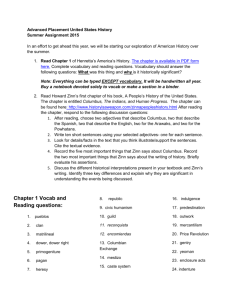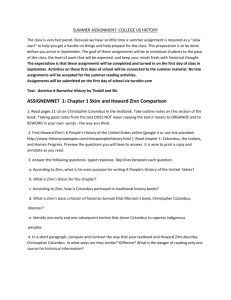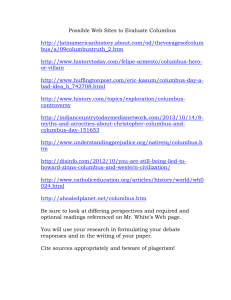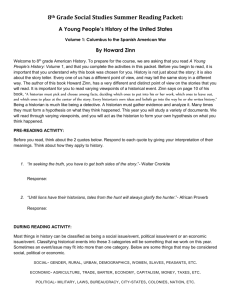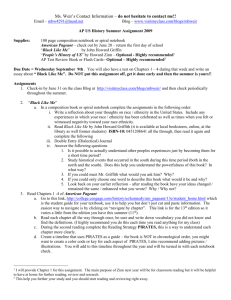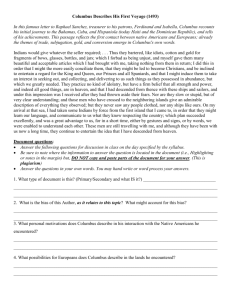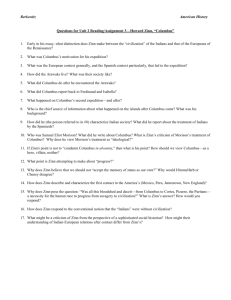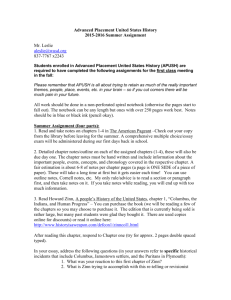PowerPoint - english amped
advertisement
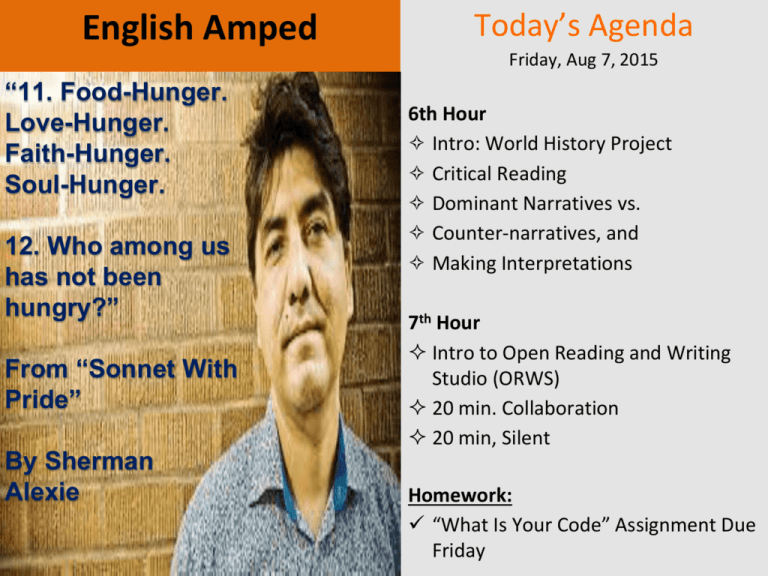
English Amped Today’s Agenda Friday, Aug 7, 2015 “11. Food-Hunger. Love-Hunger. Faith-Hunger. Soul-Hunger. 12. Who among us has not been hungry?” From “Sonnet With Pride” By Sherman Alexie 6th Hour ✧ Intro: World History Project ✧ Critical Reading ✧ Dominant Narratives vs. ✧ Counter-narratives, and ✧ Making Interpretations 7th Hour Intro to Open Reading and Writing Studio (ORWS) 20 min. Collaboration 20 min, Silent Homework: “What Is Your Code” Assignment Due Friday Remember Columbus? Like Howard Zinn, the historian who wrote the chapter we read last year on Columbus, you will be asked to examine and interpret history. Let’s review how Zinn examined the dominant narrative to write history as a counter-narrative. We need readers for “Telling Columbus’s Story,” an excerpt from Chapter 1, “Columbus and the Indians,” from Zinn’s book A Young People’s History of the United States (adapted by Rebecca Stefoff) •Narrator #1 •Las Casas (short) •Narrator #2 •Narrator #3 •Narrator #4 In this excerpt, Zinn uses •A counter-narrative about Columbus, the book History of the Indies written by Columbus’ contemporary, Las Casas, and •A dominant narrative about Columbus, the 1954 book Christopher Columbus, Mariner by Same Eliot Morrison Take 1 MINUTE to read over the “English Amped Critical Reading Toolkit.” What is a writer’s “position?” What does it mean to be a reader “from a resistant position?” What is our reading context right now? •In an afternoon class in an SBR school •Teens and an adult who have questioned Columbus as a hero •Individualized contexts Let’s practice how to •Critically read and •Critically respond To “Telling Columbus’s Story” By Howard Zinn Choose to •Walk around the room and record your responses on the chart paper. •Stay alone at your desk and record your responses on paper. •Stand with one partner at a table to record your responses on paper. TAKE 5 MINUTES TO RESPOND Choose to •Walk around the room and record your responses on the chart paper. •Stay alone at your desk and record your responses on paper. •Stand with one partner at a table to record your responses on paper. 3 MINUTES LEFT TO RESPOND Choose to •Walk around the room and record your responses on the chart paper. •Stay alone at your desk and record your responses on paper. •Stand with one partner at a table to record your responses on paper. 1 MINUTE LEFT TO RESPOND TIME TO SHARE WITH THE CLASS •What positions is the writer constructing? •What does she or he want us to think? •Who is the ideal reader? What is the ideal reading position? TIME TO SHARE WITH THE CLASS •Whose interests are being served? Who benefits? Who does not? •What insights does someone reading from a resistant position bring to the text? TIME TO SHARE WITH THE CLASS •What describes the writer’s context? •What describes our reading context? •What describes other potential reading contexts? This year, you are going to be a historian who writes about a particular time period. You will need to define your writing context and anticipate your reader’s context. Like Zinn, you will examine the dominant narrative to write your own historical analysis. •OVERARCHING PROJECT GOALS •explore your assigned time period, •analyze it in dialogue and writing, •create a presentation of your conclusions, •develop a series of lessons to teach the time period to your peers, as well as •construct a Works Cited section including further resources for learning •answer multiple choice quizzes and tests for college credit through Southeastern Timeline 8/10-8/14: Lectures 1-3 due by 8/17 8/17-8/21: Lectures 4-5 due by 8/24 Read and respond to texts 8/24-8/28: SOLE results due 8/31 Read and respond to texts 8/31-9/4: Drafts and Revisions due 9/8 9/8-9/11: Lesson Plan Drafts due 9/11 9/14-9/18: Edit papers, presentations Let’s start with an intro and model of a conclusions presentation with John Green’s “The Rise of the West and Historical Methodology: Crash Course #212.” What do you notice about… •Green’s delivery style, video cuts, images, audio, camera angles, etc.? •Questions and questioning? •Perspective, conclusions, and critiques? •Other approaches, topics, or points? You will have to •Question history •Take a perspective •Write a conclusion citing other sources, just like Green and Zinn •Create an engaging presentation Read over “General Instructions” on your handout. QUESTIONS? Write down your group members, lecture numbers, and topics: L. 1-5: Bri, Precious, Bakiari Renaissance and pre-Reformation L. 6-10: Mia, Devante, Briauna Reformation L. 11-15: Izzi, Destiny, Danni, Jalon Absolutism L. 16-20: Saida, Eric, Joe, Jaylon Enlightenment L. 21-25: Kaiya, Trey, Jayrel Revolutions and Nationalism L. 26-30: Tristen, Amber, Robin Industrial Revolution & Imperialism L. 31-35: Donni, Ronnie, Joshua World War I & Totalitarianism You have 5 minutes to get settled with your group. You have 3 minutes to get settled with your group. You have 1 minute to get settled with your group. Activity 1 With your group, read Harvard College Writing Center’s “A Brief Guide to Writing the History Paper” What stands out? What will be most helpful? Homework Reminder: Codes due Friday Tutoring: Let me know now if you plan to stay after school tomorrow. Have a wonderful rest of your day!
